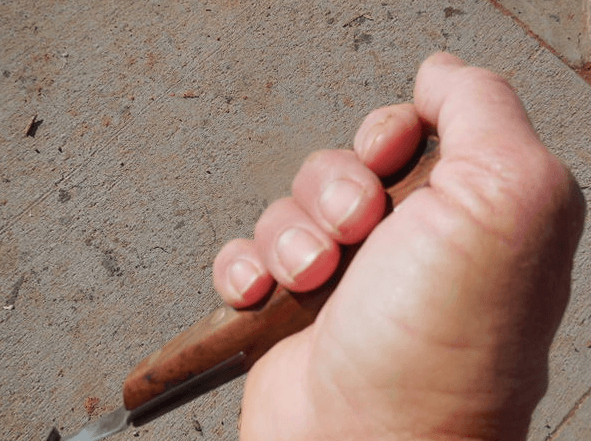Just because you own one, does not mean you always have to use it. But when you decide to use it, do it proper care. What are we talking about?
To cut a loaf of bread, which knife would you choose?
For meat cutting, which one?
Different jobs, different tools, I think we all can agree on that.
When cutting meat, which knife would make it easier on your hand, arm and wrist? Pick the knife you would choose from the two below:
Don’t want to influence your own decision making, but for me the lower knife with the broader and thicker blade would make it easier to cut a piece of meat, or, for that matter, any thick and dense tissue, like, because nothing else comes in my mind, a frog of a horse hoof, for example. Or, sole, if you like.
Now, to make it clear, I won’t discuss in this blog the ifs and what’s about frog and sole paring, that is a separate topic on itself. We just want to look at how to use a knife properly, when deciding to use one when paring hoof sole and frog.
Meanwhile you probably figured that I prefer a thick, broad bladed and smooth hoof knife when working on horses hooves. But before I even engage my hoof knife, I want to share with you a few DOs and DON’Ts:
-DON’T use your knife as a prying tool
-DON’T use your knife as a hoof pick
-DON’T use your knife as a scraper
-DON’T pull your knife
-DO clean the hoof before using a knife on it
-DO keep your knife sharp
-DO push the knife with the opposing thumb

A No-Go for your hoof knife. First clean the hoof with a wire brush.
And use a hoof pick to clean any rocks and debris from the collateral grooves.
Which hoof knife to select of all the different ones?
Here are some criteria can we use to select a Hoof Knife that will serve us for a long time. Foremost, the handle of the knife should fit, let’s just say it, like an EasyBoot Glove. Finding a comfortable handle is very important for control and performance.
When holding the handle, the tip of your middle finger should just barely touch the fleshy part of your thumb.

For my hand, this handle fits perfectly. Contrary to the images below. In the next one, the handle is to small for my hand.

In the next photo below the handle below is too big for my hand.

Too much space between my middle finger and the thumb.
Another important aspect is the blade width. Remember the second photo above in the beginning with the two kitchen knives? The broader, wider blade is the stronger one and will hold up longer. We can cut meat better with it. Same is valid for the hoof knife.
The one on the right is my first choice regarding blade width. Take a note on the different shapes of the handles.
And now comes the fun part: feeling and touching the different handles that fit your hand. It is strictly a personal preference which shape you like. Take your time, play with it, hold it, let your hand feel it. Sometimes I take half an hour holding and feeling a handle to make sure I like it.
When using the selected knife, I like to lay the knife as flat as possible onto the sole and then use a semicircle movement of my wrist by pushing the back of the blade with the thumb of my other hand. Look at the movement direction of handle and blade in the picture below, indicated by the orange arrows.

The next frame shows how my hand ends up at the end of the semicircle:
This is a safe way to use the hoof knife, you protect your wrist, elbows and tendons.
This will only work when your knife is SHARP. A dull knife is a dangerous knife, it won’t cut and will hurt you eventually.
In January 2012, three years ago, I wrote a blog: 5 Ways To Sharpen Your Knife. You may want to revisit this blog to see which way works best for you to take care of the blade. We only want to sharpen on one side, the inside or the one you look at. After you are finished sharpening, check if the blade is smooth and sharp or serrated. Let’s look at the very first image again, we do not want to saw or cut bread, we want to slice meat. The blade should be smooth, thin, razor sharp, so you can cut a piece of loosely held paper in half. Then you have a sharp and workable hoof knife. When using only a rough sanding stone or a sanding wheel, you may end up with a serrated cutting edge instead of a smooth, slick one. Use of a buffering wheel will help smoothing out any blade roughness.
From the desk of the Bootmeister
Christoph Schork
Global Endurance Training Center





